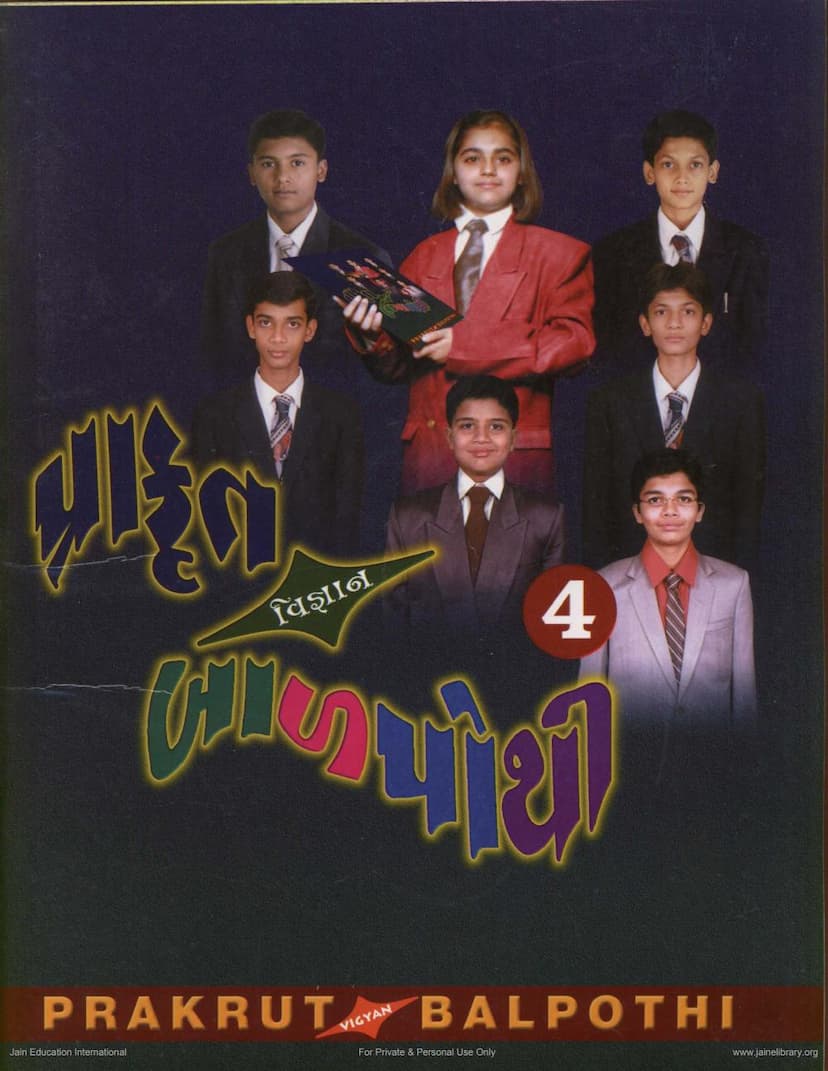Prakrit Vigyana Balpothi Part 4
Added to library: September 2, 2025

Summary
This document is "Prakrit Vigyan Balpothi Part 4" by Somchandravijay, published by Rander Road Jain Sangh. The catalog link provided is for the Jainqq.org website.
The book is part of a series dedicated to the study of Prakrit, a significant ancient language in Jainism. This particular volume focuses on teaching the basics of Prakrit to children, as evidenced by the title "Balpothi" (children's book).
Here's a breakdown of the content based on the provided pages:
-
Pages 1-6: Front Matter and Salutations: These pages include the book title, author, publisher, publication details (date, edition size, price), and dedications. It highlights the lineage of Acharyas and Gurus associated with the publication, emphasizing their contributions to Jain tradition and the Prakrit language. There are also introductory verses and messages from prominent figures in the Jain community. The overall tone is devotional and reverential.
-
Pages 7-13: Introductions and Forewords:
- Page 7-9: Introduces Acharya Vijay Kastursurishwarji M.S., the central figure of this publication. It details his life, virtues, and his dedication to the preservation and promotion of Prakrit. He is described as "Dharmaraja" (King of Dharma) and revered for his knowledge and humility. The publication of Prakrit texts in his birth centenary year is presented as a tribute to him.
- Page 10-11: The "Editorial" section explains the purpose of the "Prakrit Vigyan Balpothi" series. It mentions that the series was originally conceived 36 years prior by Acharya Vijay Kastursurishwarji with the inspiration of Raichandbhai Maganlal and Pandit Narmadashankar Shastri to teach Prakrit and Sanskrit to children. This volume is a continuation and completion of that work, updated with Sanskrit, Gujarati, and English translations to suit modern generations. It outlines the content of the four parts, mentioning Jain symbols, alphabet, vocabulary, roots, and usage.
- Page 12: The "Preface" reiterates the importance of Prakrit as the mother tongue of the Jain tradition and laments its decline due to the passage of time. It expresses hope that this series will revive interest in Prakrit and lead people to spiritual happiness.
- Page 13: Discusses the significance of Prakrit as an ancient, natural, and common language of India, used by the Tirthankaras and their disciples for religious discourses and scripture composition. It emphasizes the necessity of basic Prakrit grammar for understanding its rich literature.
-
Pages 14-38: The Core Teaching Content (Steps 1-13): This forms the bulk of the book, systematically teaching Prakrit grammar and vocabulary through various "steps." Each step typically includes:
- Grammatical Concepts: Explanations of verb conjugations (tenses, persons), noun declensions (genders, cases), pronouns, numbers, and sentence construction.
- Vocabulary (Words): Lists of Prakrit words categorized by gender and declension/conjugation types, with their Gujarati and English meanings.
- Roots (Dhatus): Prakrit verb roots and their meanings.
- Examples and Exercises: Prakrit sentences for translation into Gujarati/English and vice versa, helping students practice the grammar and vocabulary.
- Supplementary Sections: At the end of each step (or group of steps), there are supplementary sections providing Sanskrit-Gujarati-English translations of the Prakrit examples and vice versa, allowing students to check their understanding.
- Specific Topics Covered:
- Step 1 & 2: Present tense verb endings, genders, and the first three cases of nouns.
- Step 3 & 4: Declensions of masculine and neutral nouns ending in 'a', 'i', and masculine nouns ending in 'i'.
- Step 5 & 6: Declensions of masculine and neutral nouns ending in 'u' and 'ū', and past tense conjugations.
- Step 7 & 8: Feminine noun declensions for those ending in 'ā', 'ī', 'ū', and 'ū', and declensions of 'ṛ' (father) related words.
- Step 9 & 10: Pronoun declensions for 'aham' (I) and 'tum' (you), and imperative/subjunctive moods.
- Step 11 & 12: Numbers and their usage in Prakrit, and pronoun declensions for other pronouns.
- Step 13: Future tense conjugations.
-
Pages 39-50: Supplementary Sections (Detailed): These pages provide the comparative translations mentioned earlier, serving as an answer key and reinforcement for the learning steps.
-
Pages 51-61: Alphabetical Index: This is a comprehensive index of Prakrit words and roots covered in the book, listed alphabetically with their grammatical categories and meanings in Gujarati and English. This is a valuable resource for reference.
-
Pages 62-69: Stories and Moral Tales: This section includes two short stories in Prakrit with Gujarati and English translations:
- "Vinayavanta Falsaal" (Humble Falsaal): A story about a humble and respectful person named Falsaal who learns the importance of true reverence and ultimately attains spiritual liberation.
- "Dayaveero Meharaho" (Kind and Merciful Meghrath): A tale illustrating the virtue of compassion and mercy, featuring King Meghrath who sacrifices his flesh to save a pigeon from a hawk, demonstrating immense kindness.
- "Sadiyadhaṇṇassa Dāyā Settḥī" (The Merchant Who Gave Rotten Grains): A story about a miserly merchant who learns a valuable lesson about righteous giving from his wise daughter-in-law, leading him to practice true charity.
-
Pages 70-72: Concluding Pages: These pages include a concluding invocation, salutations to esteemed Gurus and Sanghs, and acknowledgments of supporters and contributors. It mentions the inauguration of the "Shri Nemi-Vigyan-Kastursuri Prakrit Pathshala" on the publication date.
Overall Purpose and Significance:
"Prakrit Vigyan Balpothi Part 4" is a pedagogical tool designed to teach the Prakrit language to children within the Jain tradition. It aims to:
- Preserve and Promote Prakrit: By making the language accessible and engaging for younger generations.
- Educate on Jain Scriptures: Prakrit is the language of many ancient Jain Agamas. Understanding Prakrit is crucial for a deeper study of Jain philosophy and literature.
- Instill Jain Values: Through the inclusion of moral stories that emphasize virtues like humility, compassion, righteous giving, and respect for elders and spiritual teachers.
- Provide a Comprehensive Learning Resource: The book systematically covers grammar, vocabulary, and includes practice exercises and a detailed index.
In essence, this book serves as a foundational text for learning Prakrit, rooted in Jain heritage and guided by the teachings of eminent Jain Acharyas.